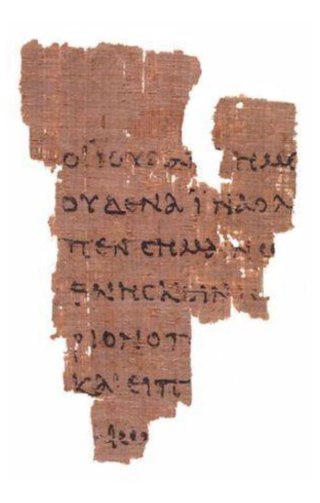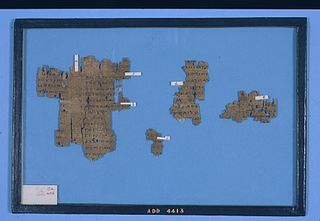The Book of Isaiah is the first of the Latter Prophets in the Hebrew Bible and the first of the Major Prophets in the Christian Old Testament. It is identified by a superscription as the words of the 8th-century BCE prophet Isaiah ben Amoz, but there is evidence that much of it was composed during the Babylonian captivity and later. Johann Christoph Döderlein suggested in 1775 that the book contained the works of two prophets separated by more than a century, and Bernhard Duhm originated the view, held as a consensus through most of the 20th century, that the book comprises three separate collections of oracles: Proto-Isaiah, containing the words of the 8th-century BCE prophet Isaiah; Deutero-Isaiah, the work of an anonymous 6th-century BCE author writing during the Exile; and Trito-Isaiah, composed after the return from Exile. Isaiah 1–33 promises judgment and restoration for Judah, Jerusalem and the nations, and chapters 34–66 presume that judgment has been pronounced and restoration follows soon. While few scholars today attribute the entire book, or even most of it, to one person, the book's essential unity has become a focus in more recent research.

Gnosticism is a collection of religious ideas and systems that coalesced in the late 1st century AD among Jewish and early Christian sects. These various groups emphasized personal spiritual knowledge (gnosis) above the proto-orthodox teachings, traditions, and authority of religious institutions. Gnostic cosmogony generally presents a distinction between a supreme, hidden God and a malevolent lesser divinity who is responsible for creating the material universe. Consequently, Gnostics considered material existence flawed or evil, and held the principal element of salvation to be direct knowledge of the hidden divinity, attained via mystical or esoteric insight. Many Gnostic texts deal not in concepts of sin and repentance, but with illusion and enlightenment.

The Gospel of John is the fourth of the four canonical gospels. It contains a highly schematic account of the ministry of Jesus, with seven "signs" culminating in the raising of Lazarus and seven "I am" discourses culminating in Thomas' proclamation of the risen Jesus as "my Lord and my God". The gospel's concluding verses set out its purpose, "that you may believe that Jesus is the Christ, the Son of God, and that believing you may have life in his name."
Gnosis is the common Greek noun for knowledge. The term was used among various Hellenistic religions and philosophies in the Greco-Roman world. It is best known for its implication within Gnosticism, where it signifies a spiritual knowledge or insight into humanity's real nature as divine, leading to the deliverance of the divine spark within humanity from the constraints of earthly existence.

Paul, commonly known as Paul the Apostle and Saint Paul, was a Christian apostle who spread the teachings of Jesus in the first-century world. Generally regarded as one of the most important figures of the Apostolic Age, he founded several Christian communities in Asia Minor and Europe from the mid-40s to the mid-50s AD.

Metatron, or Matatron, is an angel in Judaism, Christianity, and Islam mentioned three times in the Talmud, in a few brief passages in the Aggadah, and in mystical Kabbalistic texts within Rabbinic literature. The figure forms one of the traces for the presence of dualist proclivities in the otherwise monotheistic visions of both the Tanakh and later Christian doctrine. In the Jewish kabbalistic tradition, he is sometimes portrayed as serving as the celestial scribe. The name Metatron is not mentioned in the Torah or the Bible and how the name originated is a matter of debate. In Islamic tradition, he is also known as Mīṭaṭrūn, the angel of the veil.

Samael is an archangel in Talmudic and post-Talmudic lore; a figure who is the accuser or adversary, seducer, and destroyer.

Fallen angels are angels who were expelled from heaven. The literal term "fallen angel" does not appear in any Abrahamic religious texts, but is used to describe angels cast out of heaven or angels who sinned. Such angels often tempt humans to sin.

The Gospel of the Hebrews, or Gospel according to the Hebrews, is a lost Jewish–Christian gospel. The text of the gospel is lost, with only fragments of it surviving as brief quotations by the early Church Fathers and in apocryphal writings. The fragments contain traditions of Jesus' pre-existence, incarnation, baptism, and probably of his temptation, along with some of his sayings. Distinctive features include a Christology characterized by the belief that the Holy Spirit is Jesus' Divine Mother and a first resurrection appearance to James, the brother of Jesus, showing a high regard for James as the leader of the Jewish Christian church in Jerusalem. It was probably composed in Greek in the first decades of the 2nd century, and is believed to have been used by Greek-speaking Jewish Christians in Egypt during that century.

Apocalyptic literature is a genre of prophetical writing that developed in post-Exilic Jewish culture and was popular among millennialist early Christians. Apocalypse is a Greek word meaning "revelation", "an unveiling or unfolding of things not previously known and which could not be known apart from the unveiling".

The New Testament apocrypha are a number of writings by early Christians that give accounts of Jesus and his teachings, the nature of God, or the teachings of his apostles and of their lives. Some of these writings were cited as scripture by early Christians, but since the fifth century a widespread consensus has emerged limiting the New Testament to the 27 books of the modern canon. Roman Catholic, Eastern Orthodox, and Protestant churches generally do not view the New Testament apocrypha as part of the Bible.
The Odes of Solomon are a collection of 42 odes attributed to Solomon. The Odes are generally dated to either the first century or to the second century, although a few scholars have suggested a later date. The original language of the Odes is thought to have been either Greek or Syriac, and the majority of scholars believe it to have been written by a Christian, likely a convert from the Essene community to Christianity, because it contains multiple similarities to writings found in Qumran. Some have argued that the writer had even personally seen the Apostle John. A minority of scholars have suggested a Gnostic origin, but this theory is not widely supported.

The Third Epistle to the Corinthians is an early Christian text written by an unknown author claiming to be Paul the Apostle. It is also found in the Acts of Paul, and was framed as Paul's response to a letter of the Corinthians to Paul. The earliest extant copy is Papyrus Bodmer X, dating to the third century. Originally written in Koine Greek, the letter survives in Greek, Coptic, Latin, and Armenian manuscripts.

The Ascension of Isaiah is a pseudepigraphical Judeo-Christian text. Scholarly estimates regarding the date of the Ascension of Isaiah range from 70 AD to 175 AD. Many scholars believe it to be a compilation of several texts completed by an unknown Christian scribe who claimed to be the Prophet Isaiah, while an increasing number of scholars in recent years have argued that the work is a unity by a single author that may have utilized multiple sources.
The non-canonical books referenced in the Bible includes non-Biblical cultures, and lost works of known or unknown status. By the "Bible" is meant those books recognized by most Christians and Jews as being part of Old Testament as well as those recognized by some Christians as being part of the Biblical apocrypha or of the Deuterocanon.

James Hamilton Charlesworth is an American academic who served as the George L. Collord Professor of New Testament Language and Literature until January 17, 2019, and Director of the Dead Sea Scrolls Project at the Princeton Theological Seminary. His research interests include the Apocrypha and Pseudepigrapha of the Hebrew and Christian Bibles, the Dead Sea Scrolls, Josephus, the Historical Jesus, the Gospel of John, and the Book of Revelation.

Against Heresies, sometimes referred to by its Latin title Adversus Haereses, is a work of Christian theology written in Greek about the year 180 by Irenaeus, the bishop of Lugdunum.
In some Judeo-Christian traditions, the Angel of the Presence / Face or Angel of his presence / face refers to an entity variously considered angelic or else identified with God himself.

Thomasine is a name given to a Syrian Christian group that originated in the first or the second century, who especially revered the apostle Thomas and some scholars speculate to have written the gospel of Thomas. The group was said to have held esoteric, mystical, and ascetic ideas. Some have associated them with the proto-Gnostics. However modern critics have disputed their affiliation with Gnosticism, especially because they lack many uniquely Gnostic beliefs.












